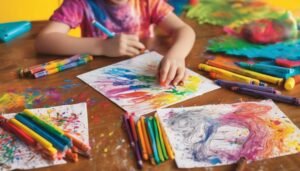It’s interesting how something as simple as coloring can unlock a child’s potential. Every stroke of the crayon not only fills a page with color but also nurtures essential skills. As you watch them create, you might notice their focus and creativity blossoming. What’s even more fascinating is how these moments contribute to their confidence and self-expression. You may wonder, what other benefits does this daily activity hold for your child’s development?
Key Takeaways
- Coloring enhances fine motor skills and hand-eye coordination, essential for future tasks like writing and using scissors.
- Engaging in coloring fosters imagination and creativity, leading to unique storytelling and artistic expression.
- The practice of coloring improves focus and concentration, helping children pay attention to details and complete tasks.
- Experimenting with colors encourages adaptability and learning from mistakes, fostering resilience in creative expression.
- Completing artwork boosts self-esteem and confidence, reinforcing a positive self-image and ownership of creative abilities.
Enhancing Fine Motor Skills
When you pick up a coloring pencil, you’re not just about to create a masterpiece; you’re also enhancing your fine motor skills. As you grasp the pencil, you’re working on your grip control, which is vital for various daily tasks.
Each stroke helps strengthen your hand muscles, improving hand strength over time. This development is crucial, especially for young kids, as it builds a solid foundation for writing, typing, and using scissors later on.
Plus, you’re refining your coordination, making your fingers more nimble and agile. So, as you color, remember that you’re doing so much more than just filling in spaces; you’re crafting your abilities and setting the stage for future successes in life.
Boosting Imagination and Creativity
Coloring not only sharpens your fine motor skills but also sparks your imagination and creativity.
When you pick up those crayons or markers, you dive into a world filled with endless possibilities. You can create imaginative scenarios that transport you to far-off lands or whimsical adventures.
Picking up crayons opens the door to limitless creativity, whisking you away to enchanting worlds and fantastical adventures.
This act of coloring allows you to express your thoughts and ideas visually, fostering creative storytelling. As you blend colors and choose themes, you’re not just filling in lines; you’re crafting narratives and characters that come to life on the page.
Each stroke invites you to explore new concepts and dream big. So, let your imagination run wild, and watch how your creativity flourishes with every coloring session you enjoy.
Encouraging Self-Expression
When you color, your choices reflect who you are, allowing your personality to shine through.
Embracing your unique art style and picking colors that resonate with your emotions can be incredibly liberating.
This process not only honors your individuality but also encourages deeper emotional expression in your artwork.
Personal Color Choices
One way to express your individuality is through the colors you choose in your artwork. Each color carries its own symbolism, and your personal preferences can reveal a lot about who you are.
For instance, you might gravitate toward bright colors like yellow or orange when you’re feeling joyful, while deeper shades like blue or purple might reflect a more introspective mood.
By experimenting with different color combinations, you can discover what resonates with you and helps convey your emotions. This process not only enhances your artistic expression but also builds your confidence in making choices.
Embrace your unique color palette; it’s a beautiful way to share your thoughts and feelings with the world.
Unique Art Styles
Exploring unique art styles can open up new avenues for self-expression and creativity. When you encourage your child to experiment with different techniques, like abstract techniques, they can discover what resonates with them.
Allow them to mix colors, shapes, and patterns freely, as this can lead to unexpected and exciting results.
Cultural influences also play a significant role in shaping artistic expression. Encourage your child to explore art from various cultures, which can inspire them to incorporate diverse elements into their work.
Emotional Expression Through Art
Art serves as a powerful outlet for emotional expression, allowing your child to communicate feelings they may struggle to articulate with words. Through coloring, they can experience an emotional release, channeling their happiness, sadness, or frustration onto the page.
This creative process becomes a therapeutic outlet, enabling them to explore their emotions safely and constructively. When your child colors, they’re not just filling in shapes; they’re giving voice to their inner world, fostering self-awareness and understanding.
Encouraging this practice can help them develop resilience and coping skills, as they learn to navigate their feelings. By embracing art as a form of self-expression, you’re providing them with a valuable tool for emotional growth and healing.
Developing Focus and Concentration
While you mightn’t realize it, coloring can be a powerful tool for developing focus and concentration. When kids immerse themselves in coloring, they practice mindful engagement, allowing their minds to center on the task at hand.
This dedicated time encourages them to block out distractions and fosters sustained attention. As they choose colors and stay within the lines, they learn to concentrate on details, enhancing their ability to focus on other activities.
Improving Hand-Eye Coordination
When you engage in coloring, you’re not just having fun; you’re also enhancing your hand-eye coordination.
Each stroke of your crayon helps improve your fine motor skills and boost your spatial awareness.
This practice builds concentration and focus, making your coloring experience even more rewarding.
Enhancing Fine Motor Skills
Coloring can significantly enhance your fine motor skills, especially in improving hand-eye coordination. As you practice different coloring techniques, you’ll notice how your control over your pencil grip improves. This helps you make precise movements, leading to better coordination between your hands and eyes.
Here’s a quick overview:
| Activity | Benefits |
|---|---|
| Coloring Shapes | Develops precision |
| Shading Techniques | Enhances control |
| Color Mixing | Improves dexterity |
| Outlining | Strengthens grip |
| Detailed Patterns | Boosts focus and coordination |
Boosting Spatial Awareness
As you immerse yourself in the world of coloring, you’ll find that it significantly boosts your spatial awareness. Engaging in this creative activity sharpens your spatial reasoning and helps you understand geometric shapes better.
Here are a few ways coloring enhances these skills:
- Understanding Dimensions: Coloring different shapes helps you visualize how they fit together in space.
- Hand-Eye Coordination: Precision in coloring within lines strengthens your ability to coordinate movements.
- Perspective Skills: Using colors and shading teaches you to perceive depth and dimension.
- Problem-Solving: Choosing colors for various shapes encourages critical thinking about spatial relationships.
Developing Concentration Focus
Engaging in creative activities not only enhances spatial awareness but also plays a vital role in developing your concentration and hand-eye coordination.
When you color, you’re practicing mindfulness techniques that help you focus your attention on the task at hand. This focused engagement fosters cognitive engagement, allowing your brain to strengthen connections between visual input and motor output.
Each stroke of the crayon or marker requires precision, honing your ability to control movements. Over time, as you immerse yourself in coloring, you’ll notice improved concentration levels and coordination skills.
Embrace this creative outlet as a way to build discipline and enhance your overall cognitive abilities. It’s a fun journey that benefits both your mind and motor skills!
Fostering Problem-Solving Abilities
While you might see coloring as a simple pastime, it actually offers a unique way to enhance your problem-solving skills. Engaging in coloring helps you develop critical thinking and encourages the exploration of creative solutions.
Coloring is more than a hobby; it enhances problem-solving skills and fosters critical thinking and creativity.
Here’s how:
- Decision-Making: Choosing colors requires you to make quick decisions about what looks best.
- Experimentation: Trying different color combinations fosters a willingness to experiment and learn from mistakes.
- Visual Problem-Solving: Figuring out how to blend colors or stay within lines challenges your ability to visualize solutions.
- Adaptability: If a color doesn’t work, you learn to adapt and find alternatives, a key aspect of problem-solving.
Incorporating coloring into your daily routine nurtures these essential skills, setting you on the path to becoming a more effective problem solver.
Building Confidence and Self-Esteem
Coloring isn’t just about creating a pretty picture; it’s a powerful tool for building confidence and self-esteem. When kids express themselves through colors and designs, they engage in self-acceptance practices that help them embrace their uniqueness.
Each stroke of the crayon allows them to make choices, fostering a sense of control and ownership over their creations. As they complete their artwork, they receive a boost of accomplishment, reinforcing positive affirmations about their abilities. This process nurtures a belief in their skills, helping them tackle challenges beyond coloring.
Encouraging daily coloring can lead to a healthier self-image, as children learn to appreciate their creativity and develop the confidence they need to face the world with pride.
Understanding Color Theory and Aesthetics
Understanding color theory and aesthetics is essential for unlocking the full potential of your creative expression. By grasping these concepts, you can enhance your artwork significantly.
Here are four key elements to consider:
- Color Symbolism: Different colors evoke specific emotions and ideas. For example, red can symbolize passion, while blue often represents calmness.
- Color Combinations: Experiment with complementary and analogous colors to create harmony in your artwork.
- Contrast: Use contrasting colors to make certain elements stand out, adding depth and interest.
- Mood: Consider how your color choices affect the overall mood of your piece, influencing how others perceive your work.
Embrace these principles, and you’ll find yourself creating even more engaging and expressive art.
Frequently Asked Questions
What Age Is Best for Introducing Coloring to Children?
Introducing coloring around 18 months is ideal, as toddlers show readiness for creative expression. Keep in mind their coloring milestones, offering encouragement and support as they explore colors and shapes, fostering their confidence and imagination.
How Often Should Kids Color for Optimal Benefits?
Aim for daily coloring sessions, even if just for a few minutes. Consistent coloring frequency helps kids develop essential skills, boosts their creativity, and provides a calming routine. You’ll notice their progress and joy over time!
Can Coloring Help With Emotional Development in Kids?
Absolutely! Coloring’s like a magical portal for kids, offering emotional expression and stress relief. It helps them process feelings, encouraging calmness and creativity, while building resilience and understanding in their emotional development journey.
Are There Specific Coloring Tools That Enhance Skills?
Absolutely! Using colored pencils can improve fine motor skills, while watercolor paints encourage creativity and experimentation. Both tools enhance artistic expression and emotional growth, making them excellent choices for nurturing your child’s development through coloring.
How Can Parents Encourage Creativity During Coloring Sessions?
To spark creativity during coloring sessions, you can toss around fun coloring prompts and explore creative themes together. It’ll not only brighten their day but also help them think outside the box while having fun!
Conclusion
Incorporating coloring into your child’s daily routine can unlock a treasure trove of creative skills that benefit their growth and development. As they explore colors and shapes, they’ll not only enhance their fine motor skills but also boost their imagination and self-expression. Isn’t it amazing how something as simple as coloring can nurture resilience and confidence? By encouraging this practice, you’re giving your child the tools to navigate their artistic journey and embrace their unique identity.




